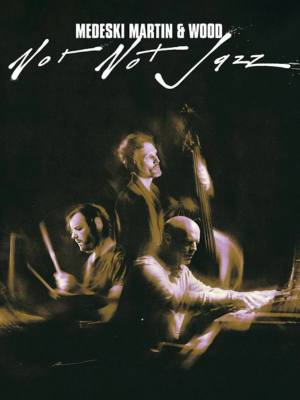
In “Not Not Jazz” – a documentary on the jazz fusion trio Medeski Martin & Wood, there is also a scene where the microphone is stalkingly maimed around the body of the bassist, Chris Wood as the latter is working his way through the bowing of the upright bass on an upstate New York tennis court strewn with dead leaves. There are other such scenes in “Not not Jazz,” which I think if you care about how music is made rather than just the music, this will be one of the things you will enjoy the most about the film in question.
This blurry documentary directed by Jason Miller (the camera operator Htat Lin Htut should be credited as a fourth member of the band rather than one of the camera operators due to his musical composition captured during recording) “Not Not Jazz” is a short feature not lasting longer than 74 minutes without credits. For this viewer at least it perhaps feels somewhat to short and feels that the premise that it is about being inside a studio in the Hudson Valley’s Allaire Studios and watching a band make a new record in which a lot of improvisation is used is delivered rather poorly.
Nor does the film go the other way and morph into the overly self-indulgent and self-hating decadence that it very well could have gotten away with.
(The audience consists mainly of people who love the band and/or jazz-related music 95 percent of the time anyway.) There are some internal strivings that took place within the band which are mentioned but not gone into. The most that we get is that it was rather casually stated by their manager Liz Penta (who produced the film) that the band had to attend group therapy and there was a lot of crying.
Even so, this is a nice piece of work which makes up for the deficiencies and omissions by giving you things that you do not often get in music documentaries. If you have ever been in a band, or know anyone who has been in a band, you will be able to appreciate the chemistry between Wood, percussionist Billy Martin and keyboardist John Medeski. Such t and young adult psychologists have been together long enough 33 years that, not only have they built up a comradeship but a form of communication made out of patches of sounds, words, and playing.
“Not Not Jazz” does not, however, give many chances to view art being created as often as “Not Not Jazz” does — simply showing artists at work is for Prescreen much too simple. Focus focuses on how the artist creates rather than standard cutaway shots of one of the band members in softly-lit woods accompanied by the voice-over of a band member. The start of any given piece may be trying to figure out the catchy tune and drum beat to go along with it; the three guys try out various tunes, then one or more of them cuts them up and shapes them in a room (e.g. kitchen) where two or all of the musicians are listening to a piece in progress and in their minds forming ideas on how it should sound or look.
At times, one of them would remark, “what if I doot-doot-doot, doot-doot-doot-doot?” and the other one is likely to reply to it or make sounds that are impressive with theirs. They help each other finish their own sentences. In some cases, they do not even bother to finish a construction. One word will go, “right, right,” and that is it.
The road leading to the cozy and comfortable place was evidently not easy. The band achieved its peak in the late 90s, when even recording labels such as Blue Note Records – now home to many legends of jazz – still invested in the productions of a purely instrumental project like Medeski, Martin & Wood. After that, the record labels cut back most of the support they had for that genre of music and the band had to simply find its way in the market.
They beat the odds because they had a clear understanding of who they were at an early stage and rather retreated into that self-image without trying to do anything that came across as being corporate (whether jazz is any form of commerce is probably something for a different film which I would love to watch). Penta—who booked them into CB’s Gallery — the avant-garde boutique space within CBGB’s in New York City — Says the guys had a feeling that their music would connect with a broader rock audience if they could get it out to them.
Under Penta’s management the band had their first real manager who was willing to put them into the hardcore punk circuits which suited them greatly. “They are all learned jazz or classical musicians” she says; “but they thought that this kind of music did not belong in jazz clubs which are elitist and pricey. They wanted to take that music into rock clubs (because) people could access it.” .
Also, Read On Fmovies
